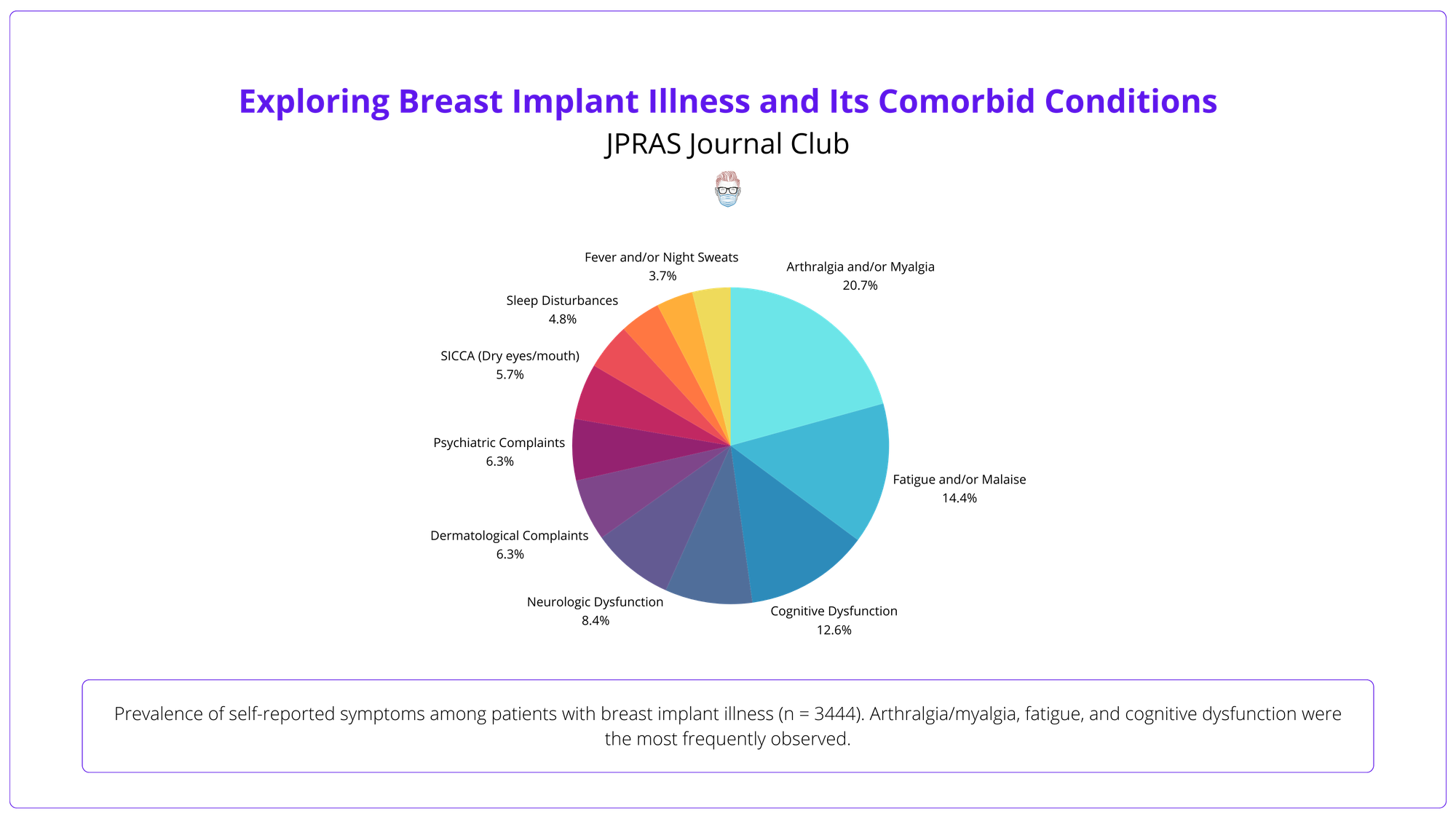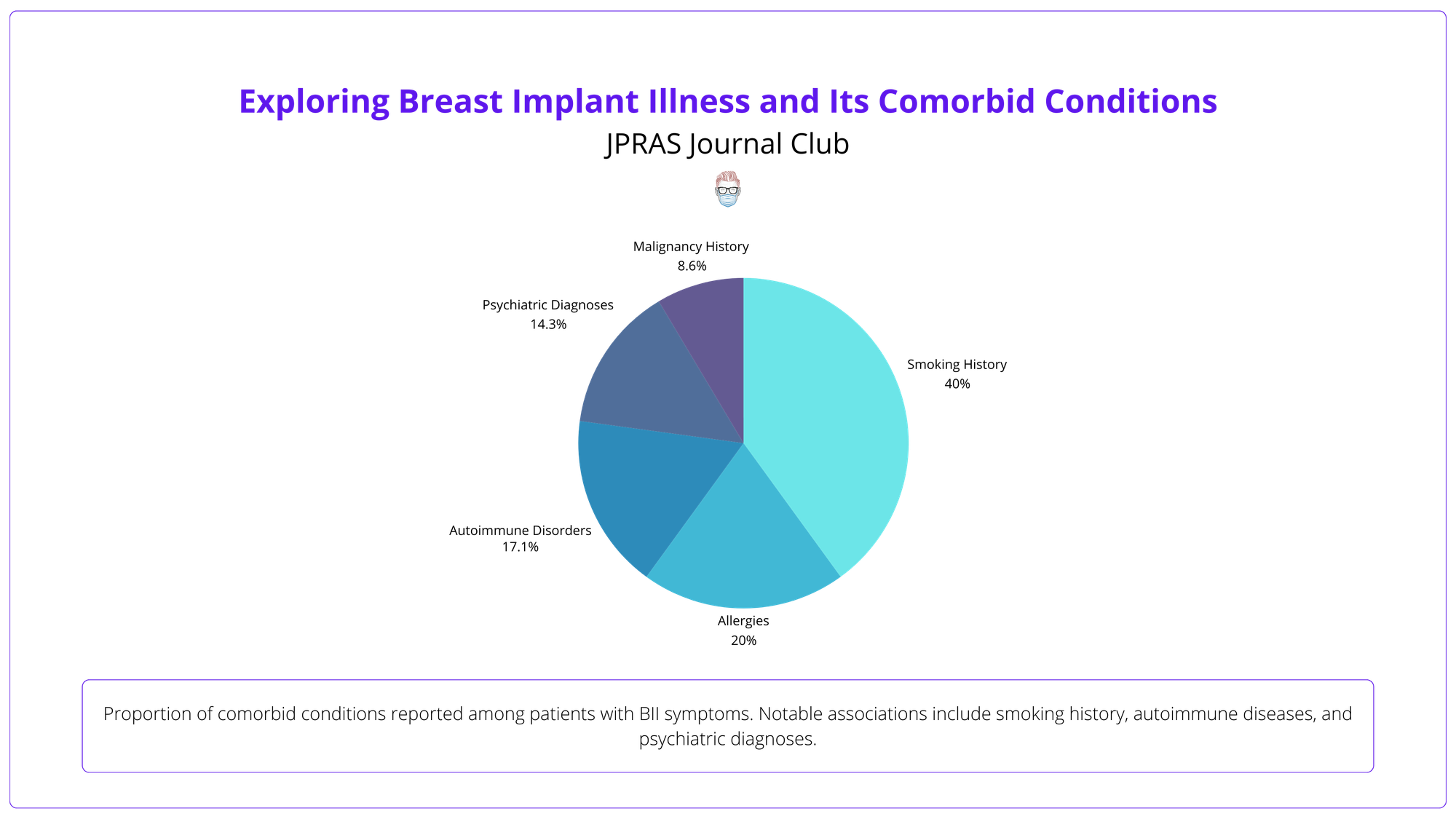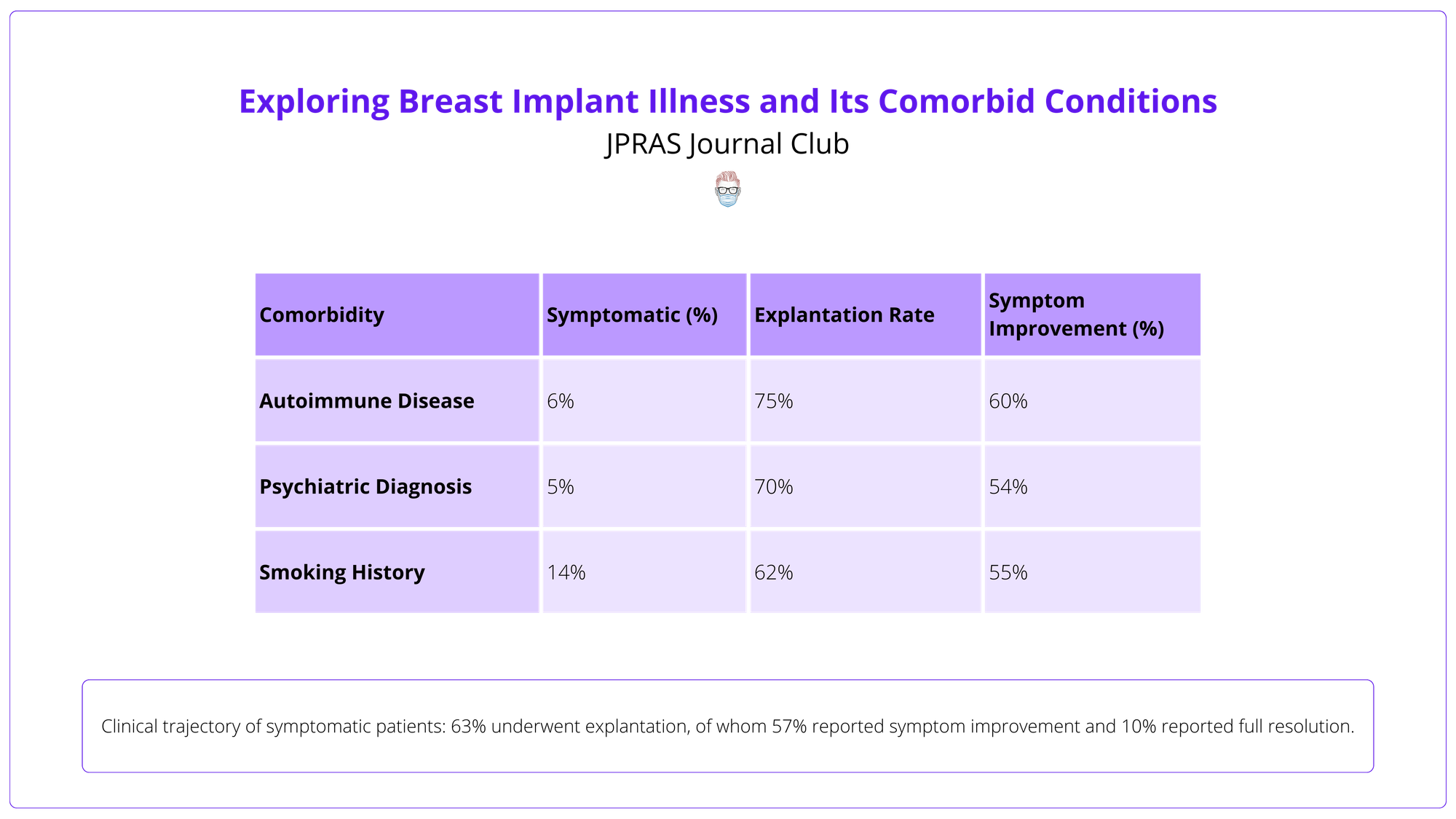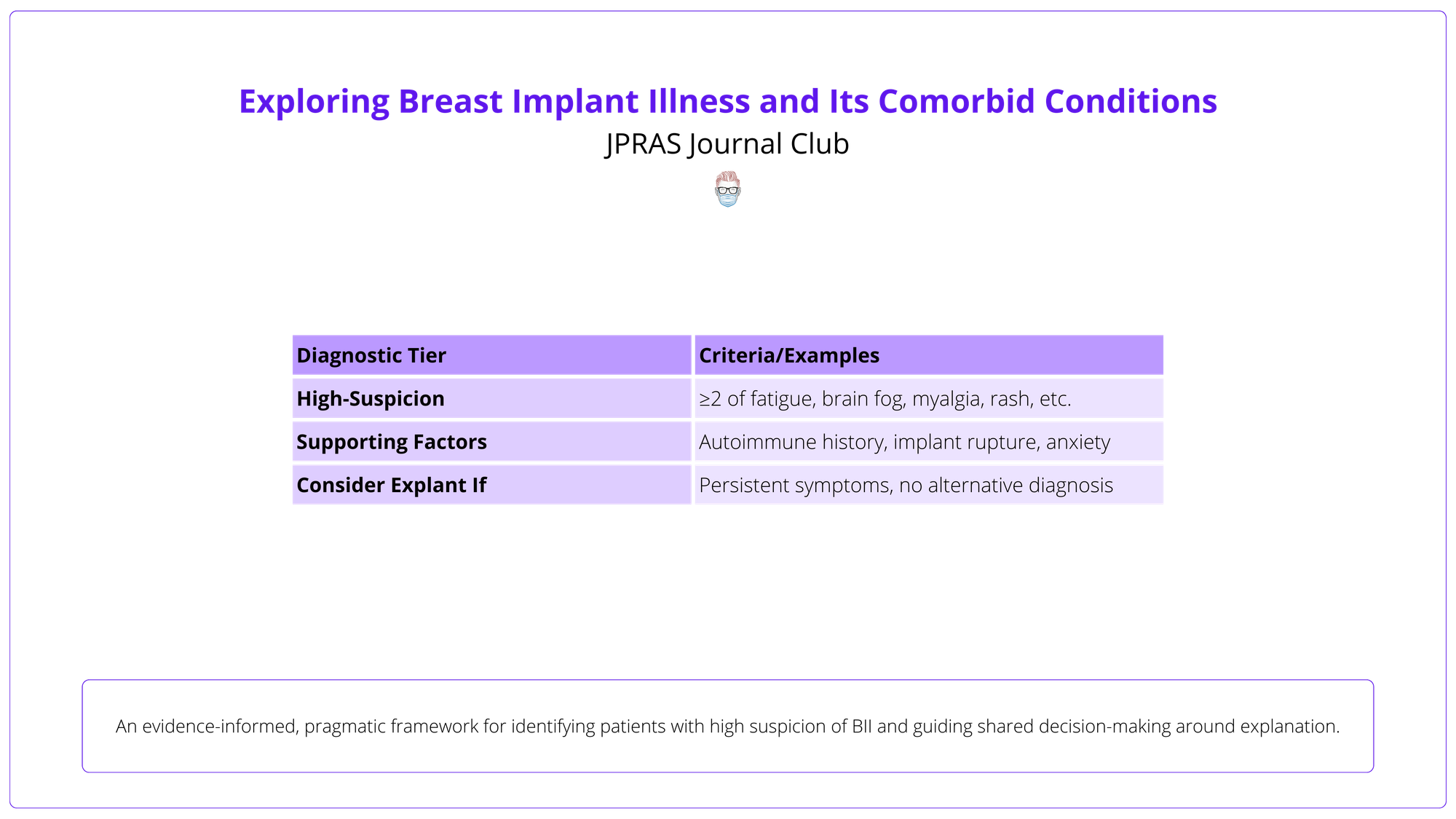In this Journal Club
A 2018–2024 systematic review of 7045 breast implant patients found that 49% reported Breast Implant Illness (BII) symptoms, mainly fatigue, joint pain, and brain fog. Over half improved after explantation. Autoimmune, psychiatric, and cancer-related comorbidities were common. Diagnosis remains unclear, stressing the need for thorough assessment and shared decision-making.
5-Point Summary
BII is a systemic symptom cluster linked to breast implants. Among 7045 patients in 48 studies, 49% reported symptoms (fatigue, joint pain, brain fog). Of those explanted, 57% improved. Autoimmune and psychiatric comorbidities were common.
4-Key Findings
Of the patients, 49% had symptoms: fatigue (24%), joint pain (34%), and brain fog (21%). Explantation was done in 63%, with 57% noting improvement. Autoimmune (6%), psychiatric (5%), and cancer histories (3%) were common. Complete symptom resolution occurred in 10%.
3-Critiques
BII lacks diagnostic criteria, and symptoms often overlap with other conditions. Study quality varied, with many small or retrospective reports. Self-selection likely inflated symptom prevalence.
2-Practical Takeaways
BII should be considered in patients with vague symptoms and implants. For ongoing symptoms, explantation may help and should be discussed as part of patient-centred care.
1-Recommended Reading
Glicksman et al.’s ASERF study (2022) explores the impact of capsulectomy type on symptom resolution after explantation, offering detailed guidance on surgical approach and outcomes.
Breast implant illness (BII) has not been designated as a defined disease entity by the World Health Organisation and is therefore very difficult to review systematically. This paper by Trabilsy et al used a search strategy designed to select ‘BII’ cohorts and sought to identify the common self-reported symptoms in those patients; therefore, frequency of symptoms and rate of explantation should be interpreted in that context. Arthralgia, fatigue and cognitive dysfunction were the most common complaints, which are also symptoms frequent to other disease entities and the general population. Extensive prospective data collection of patients with breast implants will be required to provide evidence of causation. This is a valuable paper to raise awareness in plastic surgeons that patients with breast implants and symptoms of BII should be taken seriously and a differential diagnosis considered prior to surgical intervention.
Adam Reid
JPRAS Editors
5 Point Summary
This systematic review and meta-analysis synthesises data from 48 studies on breast implant illness (BII), evaluating symptom prevalence, associated comorbidities, and post-explantation outcomes in a global patient population.
Patients with breast implants report systemic symptoms associated with BII, and these symptoms may improve following explantation.
2️⃣ Method
A systematic review and meta-analysis of 48 studies (2018–2024) including 7045 patients, evaluating presenting symptoms, associated comorbidities, and explantation outcomes.
3️⃣ Results
49% of patients reported BII symptoms, with fatigue, joint pain, and brain fog most common. 63% underwent explantation; 57% experienced improvement and 10% had complete resolution.
4️⃣ Conclusion
BII represents a complex, multifactorial syndrome often overlapping with autoimmune, psychiatric, and oncologic conditions. Symptom relief is common post-explant.
5️⃣ Implication
Clinicians should consider BII in symptomatic patients and support shared decision-making, particularly when nonspecific symptoms persist without a clear medical cause.
4 Key Findings
This global review highlights the symptom burden and clinical outcomes associated with breast implant illness, with important patterns in presentation, comorbidities, and surgical management.
The most common BII symptoms were arthralgia/myalgia (34%), fatigue/malaise (24%), and cognitive dysfunction such as brain fog (21%). Many patients reported more than one symptom, forming a consistent clinical cluster. Symptom clusters reported by patients often reflect systemic or inflammatory patterns.

Comorbidities were frequently observed: 14% had a history of smoking, 6% had autoimmune diseases, and 5% had psychiatric conditions such as anxiety or depression. A smaller subset (3%) had a history of malignancy.

63% of symptomatic patients underwent implant removal. Among those, 57% reported symptom improvement and 10% had complete resolution. The association between explantation and relief was statistically significant across the studies.

BII remains poorly defined, with subjective reporting, overlapping diagnoses, and varied study quality. Despite this, the consistent post-explant improvement seen in multiple studies reinforces the need for patient-centred management.
3 Critiques
While comprehensive and globally representative, the review is limited by variability in study design, subjective symptom reporting, and potential bias in patient selection.
BII lacks a standardised definition or objective diagnostic criteria, leading to heterogeneity in how symptoms were identified and reported across studies.
The review included case reports, small case series, and non-randomised studies with differing methodologies, limiting the strength of pooled conclusions and meta-analysis accuracy.
Many included studies involved patients who already associated their symptoms with implants or were seeking explantation, introducing bias in symptom prevalence and explantation outcomes.
2 Practical Takeaways
This review offers important guidance for recognising and managing breast implant illness, emphasising the value of symptom pattern recognition and the role of explantation in patient care.
Patients presenting with vague but persistent symptoms—such as fatigue, joint pain, and brain fog—should prompt consideration of BII, especially when no alternative diagnosis is found.
Explantation may lead to meaningful symptom improvement in selected patients. Shared decision-making and appropriate counselling are essential when discussing treatment options.

1 Recommended Reading
Glicksman et al.’s ASERF study (2022) investigates the impact of capsulectomy type on symptom resolution after explantation in BII patients, offering valuable guidance on surgical approach and outcome expectations.
Read the Article

